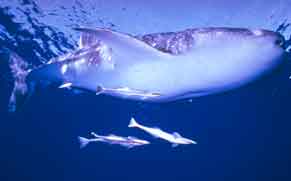
|
|
|
|
|
|
Shark Info (03-15-2001) |
Author |
|
Intro: |
Shark Info |
|
Main article: |
Dr. E. K. Ritter |
|
Article 1: |
John McKinney |
|
Article 2: |
Shark Info |
|
Article 3: |
Dr. E. K. Ritter |
|
Article 4: |
Shark Info |
|
Fact Sheet: |
Dr. E. K. Ritter |
|
Whale shark tourism in the PhilippinesReport by Shark Info Background
A 1997 study carried out by the WWF Philippines and Silliman University investigated the process of catching and trading whale sharks (Rhincodon typus) in the Philippines. Results of the study showed that in 1993 only six villages captured and traded whale sharks. By 1997 the number of villages trading with whale sharks rose to 17. Back in 1993 approximately 26 whale sharks were captured per year and per village, while in 1997 only 11 per village were pulled ashore (or approx. 190 animals per year). This decline shows that the number of whale sharks in the waters off the Philippines no longer suffices to feed 17 villages and that whale shark populations cannot compensate their losses fast enough through offspring. Whale sharks are thus a classical example of overfishing. The main reason why whale shark catches in the Philippines sharply increased since 1993 was the heightened interest in whale shark meat and the resulting higher prices. The whale shark, or so-called "Tofu shark", brings the highest prices on the Taiwanese market.
Local government offices have now reacted to this situation by prohibiting the catching and trading of whale sharks. Since protection cannot be achieved solely through prohibition, a program was simultaneously developed with the purpose of promoting ecotourism with this shark species.
EcotourismIn January 1998 several whale sharks had gathered off the coast of Donson (Sorsogan, southern Luzon, Philippines). Immediately the local touristic office known as the Sorsogon Provincial Tourism Council tried to declare the region as a tourist attraction. Media reports attracted an influx of tourists who wanted to see this natural spectacle, and the local population appeared to profit from this situation. However, the same whale sharks also attracted fishermen. In order to initiate legal measures against fishing in these waters, the government of Donsol passed a law in early March 1998 which was designed to protect the whale sharks in their territorial/communal waters. Despite this law seven whale sharks were still killed, triggering a nationwide alarm. End of March a national resolution known as the "Fishery Administrative Order 193" was passed to protect both whale sharks and manta rays, another overfished species. ConclusionEcotourism in the Philippines has become an alternative to fishing and should be supported under all circumstances. Initial results for the years 1998 and 1999 were promising. May be published only by indicating the source: Shark Info |
|
|
|
|
|
|||||
